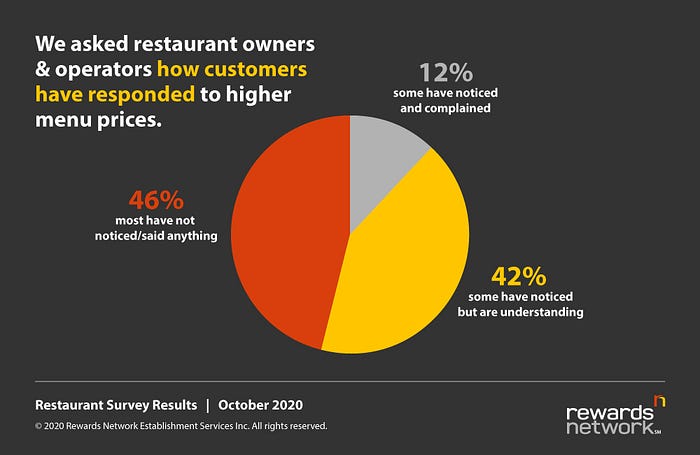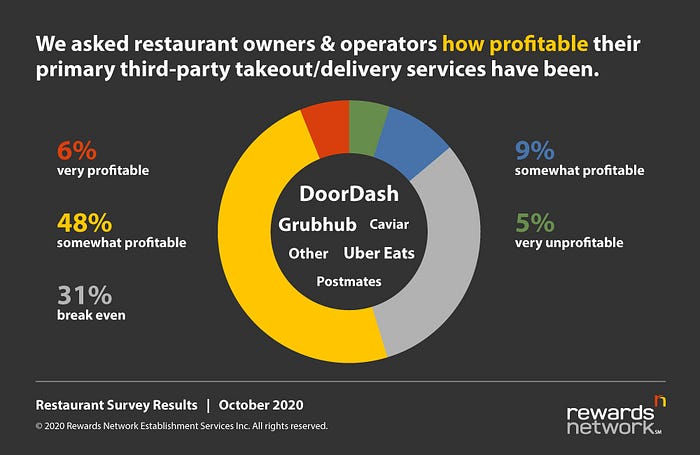Why I Love Third Party Delivery.
I’m sick of the haters. Tired of restaurants playing the victim card. Done with media demonizing third-party delivery with one-sided articles. It’s time to share the other side of the story. I have a different perspective and I know I’m not alone. Here’s my confession: I love third-party delivery. Rather than just complain, we made it work for us. This may be an unpopular opinion, but hear me out and I’ll explain.

It makes me sad when restaurants beg you to pick-up and not order delivery. Aren’t we in the so-called hospitality industry? Shouldn’t we support you doing what’s best for you— not guilt trip you into doing what’s best for us?
I want you to know you never have to feel bad for ordering from Wolf Down on Uber Eats. We appreciate every order, wherever it comes from. Besides, I totally understand if you prefer to stay home on a cold day or if it’s just easier when you have kids or a puppy at home. Maybe you don’t have a car or rather not deal with parking. I don’t even care if you’re just feeling kinda lazy today — I have those days too. Whatever your reason, I get it. Thank you for supporting.
But, there’s a catch. I have to charge you a bit more for the convenience. Why? Third-party delivery services were afraid to charge you the true cost of delivery, so instead they put it on us. It’s not your fault, but unfortunately this has skewed our perception of what on-demand delivery truly costs. To pay for this, they charge us around 30%. Problem is, average restaurant margins are only around 5–15%. Clearly this doesn’t add up. We have no choice but to increase prices for delivery in order to offering you that option.
“In 2010, I founded my own delivery app. We charged restaurants only 10 cents per order, and charged the consumer a flat fee. Restaurants were immediately on our side, and we quickly signed up hundreds. The hard part was convincing consumers to actually accept higher prices on delivery. After two years of unsuccessfully trying to get diners to pay, we had to pivot or risk failing.” — Eater
So here’s the deal: our döner is $12 in-store vs $14.50 on Uber Eats (before you freak out, that’s $CAD, so like USD $9.50 vs $11.50). We increase prices by 21% and the rest we make up in efficiency gains and labor cost savings. I basically made it my goal to be agnostic whether you order direct or through third-party delivery, so you can do whatever you want.
“The digital business is less labor intensive and more efficient.” — Forbes
This system has the added benefit of making us pretty pandemic-proof since we can easily shift sales from dine-in to delivery, or vice versa, without affecting our bottom line. Plus, it allows us to continue feeding you during quarantines, stay-at-home orders, and lock downs.
PS Too many restaurants still think they’re not allowed to increase prices on 3PD. It’s true they didn’t allow this in the beginning, but things change, and now you can. Tons of restaurants do it, so don’t worry about it.

Now, for those who think the 30% fee is robbery, first of all, let’s remember that we willingly signed up for this. Next, let’s break it down.
I’ll start with one of our most common orders: just one döner. At $14.50, we pay Uber Eats $4.35 (30%) to deliver it for us. So the question is, could I deliver it myself for $4.35? I heard on ClubHouse that drivers average 2.5 deliveries per hour. If we pay $15/hour, each delivery costs us $6. So for a single person, we can’t do it cheaper.
Besides, it’s really not that simple. For one, as opposed to only paying Uber Eats when we have a delivery, we’d have to pay our drivers even when there’s no orders. Considering this, it’s optimistic to believe we’d average even 2 deliveries per hour taking into account how unpredictable order timing is and down-time between orders. So, the true cost is more like $8–12 per delivery. An independent restaurant simply does not have the scale to optimize costs.
To deliver ourselves, at the same price as in-store, we’d have to charge at least $20 ($12 + $8). I just checked on Uber Eats and my total was $18.06. If you live alone and just want to enjoy one döner, third-party delivery is the best way for us to make that happen for you. That alone is reason enough for me to love third-party delivery.
How about another example. Our average ticket size on Uber Eats is $28, meaning we pay Uber Eats $8.40. So maybe we should just do it ourselves right? Again, it’s not that simple. During dinner rush we often have 20+ drivers per hour picking up orders. Since people want their food fast, we’d need at least 10 drivers to handle this. Our entire crew is just 10 people! We’d have to double our staff. That’s a massive headache I definitely don’t need.
So you see, it really depends on order value. For small orders, the 30% fee is less than it would cost us to deliver ourselves. It’s only on larger orders ($50+) that it starts to be more cost-effective to do it ourselves — though we still couldn’t match the level of on-demand convenience. Besides, if we adjust our pricing properly, it’s all the same to us.
If still not convinced, try delivering yourself. We tested this, not so much as an alternative for 3PD, but rather to reach customers outside the radius. It was tedious and eye-opening. We couldn’t do on-demand so we had customers submit requests and then set specific delivery nights. I spent hours replying to customers and coordinating delivery routes. Ultimately, it was slightly profitable (only because we charged $5-$10 per delivery), but it was so much work that it was neither worthwhile, nor sustainable.
At the end of the day, there’s just no way we can deliver as efficiently. Economies of scale need scale — and that’s what third-party delivery does best. For more on this, you can check out my previous blog ‘Why Uber Eats is a Necessary Evil’.
In response to the article ‘The True Cost of Convenience’, maybe we should be the ones asking ourselves — what’s it worth to me to have an army of drivers at my fingertips ready to deliver my food to you whenever you crave it? To me, it’s worth a whole lot.

Now lets switch gears and consider this: when someone orders delivery, are they ordering delivery rather than picking-up (cannibalizing sales), or are they ordering from you rather than making food at home (increasing sales)? What if third-party delivery isn’t so much a substitute for dine-in or pick-up as an alternative to cooking at home?
“The restaurant industry has evolved, focusing more on getting food into homes. The growth in off-premise will mean more food eaten at home will be prepared elsewhere.” — Restaurant Business
Personally, I don’t order delivery instead of going to restaurants (I love going out to eat) — I get delivery instead of getting groceries. In my opinion, third-party delivery isn’t stealing customers so much as adding a new sales channel and expanding the market for restaurant food consumption by making it so easy to enjoy at home. Uber Eats has introduced Wolf Down to thousands of new customers — like Calvin here.

Not only have we gained thousands of new customers thanks to Uber Eats, we even have delivery regulars. It makes us smile when we see their names pop up on-screen. Seriously, Uber Eats even shows us how many times a customer has ordered from us… many, like Justin below, are over 100!

“Restaurants need to understand third-party delivery as both an operational and marketing cost. It offers an extremely valuable platform to reach new customers, increase brand visibility, and to ring up off-premise sales.” — Forbes
Let us also not forget that Uber Eats, DoorDash, GrubHub and friends are marketing machines. Many of our customers discovered Wolf Down scrolling through Uber Eats. Some order delivery once and love it so much they come by and tell us about it. We’ve even hired staff that first found us on Uber Eats.
“DoorDash offers us the ability to reach an audience that is totally different and grow our sales incrementally.” — Forbes
On that note, just a quick comment on the recent Super Bowl ad outrage. Do I think it was a dumb commercial? Yes. Am I mad at them for marketing? No. How do you think they got all those customers on the app to order from you? Besides, if the ad cost $5.5million and Uber Eats has over 500k restaurants, that’s less than $10 per restaurant. Now what if it got someone to sign up for Uber Eats, stumble across your restaurant, try your food, love it, and now you have a new customer for life. Worth it? I’m game.

I know you guys love to hear me rant, so here we go. Of course it’s not all rainbows and unicorns. There’s no denying third-party delivery partners can be frustrating AF.
Trust me, I chewed out Skip for robbing us so many times before finally just cancelling them. I’ll give you an example. I notice a $65 chargeback on our dashboard. I click for details: “customer did not receive order”. Weird… I check the timeline: “8:54 Order accepted. 8:57 Order picked up. 9:08 Order delivered.” It says right there they picked up the order, so clearly we did our part. I call support. They tell me on their end it says: ‘Customer received burritos, not döner’. So they delivered the wrong bag — and charged us for it!? Wtf!? They agree it’s not our fault (duh!) and promise a full refund. But, how does this even happen in the first place?!
Uber Eats on the other hand likes to issue refunds either with no explanation or with an explanation that doesn’t make any sense. For example, an order for a döner and a drink says the döner was missing. We’re not perfect, but I can guarantee you we don’t send out bags with just a can of Coke. So either the customer is lying, or the driver was hungry. Either way, pay me my money.
The point is, I never said 3PD partners don’t sometimes suck or that you shouldn’t keep a close eye on them. But in my experience they’ve helped far more than hurt us. No partner is perfect. It’s not an excuse. Just a reminder we’re all human.

“More than ever, people want convenience. According to a study, 63% of young adults use third-party delivery apps. With the right approach, it can be more valuable than ever helping restaurants set themselves up for success.” — Forbes
I read this quote the other day and just had to laugh: “They say the onus is on us to make it sustainable, but this is not a service we asked for.” Ya, and Blockbuster didn’t ask for Netflix either, but here we are. So yes, the onus is on us. It’s not for everyone. But if you do it right, it can be not just sustainable, but profitable.
At the end of the day, it comes down to whether people want your food. Delivery won’t save a struggling brand. But, for restaurants with high demand, who are willing to innovate, it expands our market.

Since the pandemic, Wolf Down is doing over 50% of our sales on Uber Eats. It has allowed us to keep all our staff employed and customers fed. Uber Eats has delivered over 25,000 Wolf Down orders — more than 50,000 döners. As a small independent fast casual restaurant, it’s allowed us not just to survive, but to thrive, even during a pandemic. So ya, that’s why I love third-party delivery. And it’s fine if you don’t agree.
